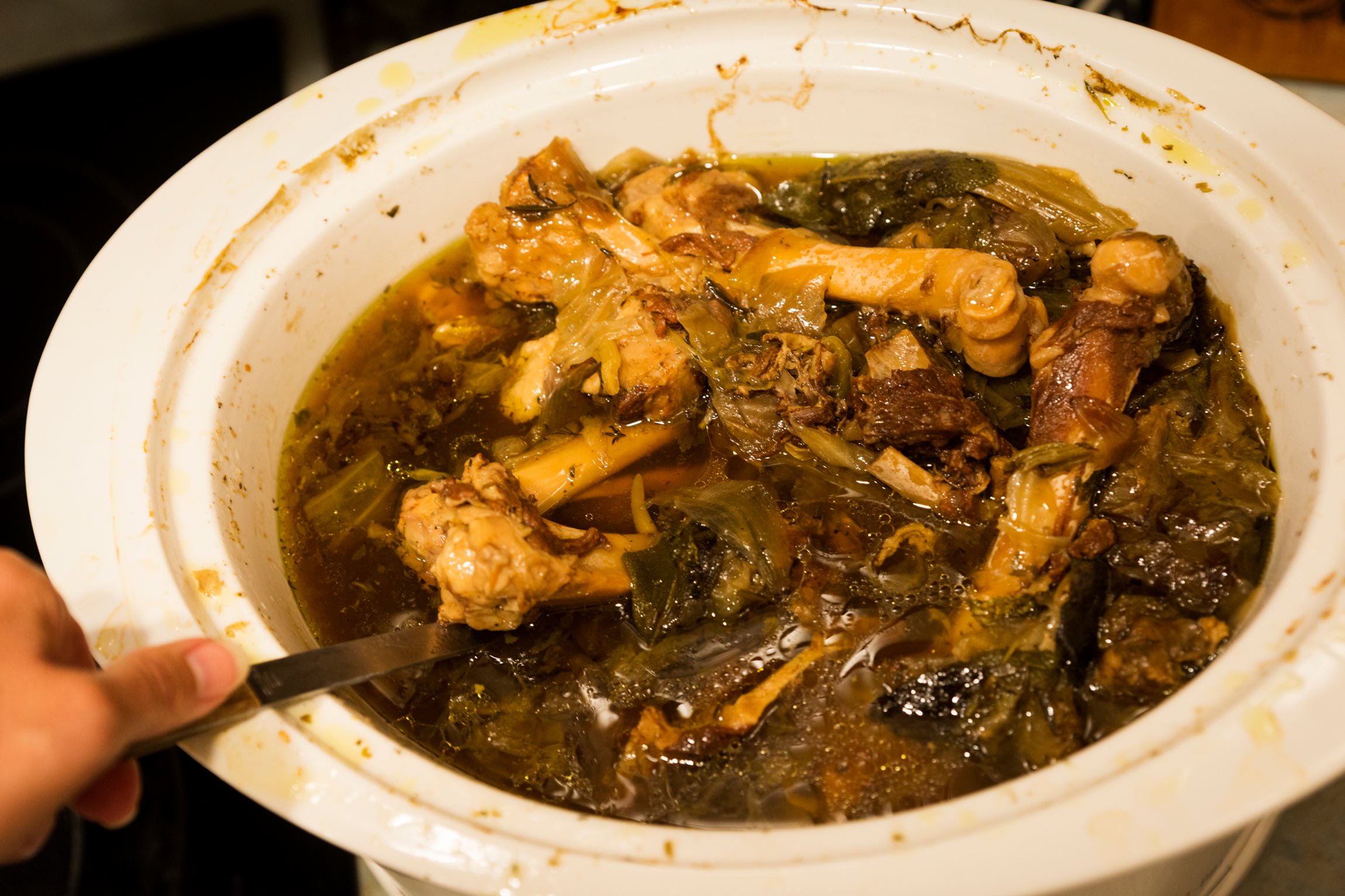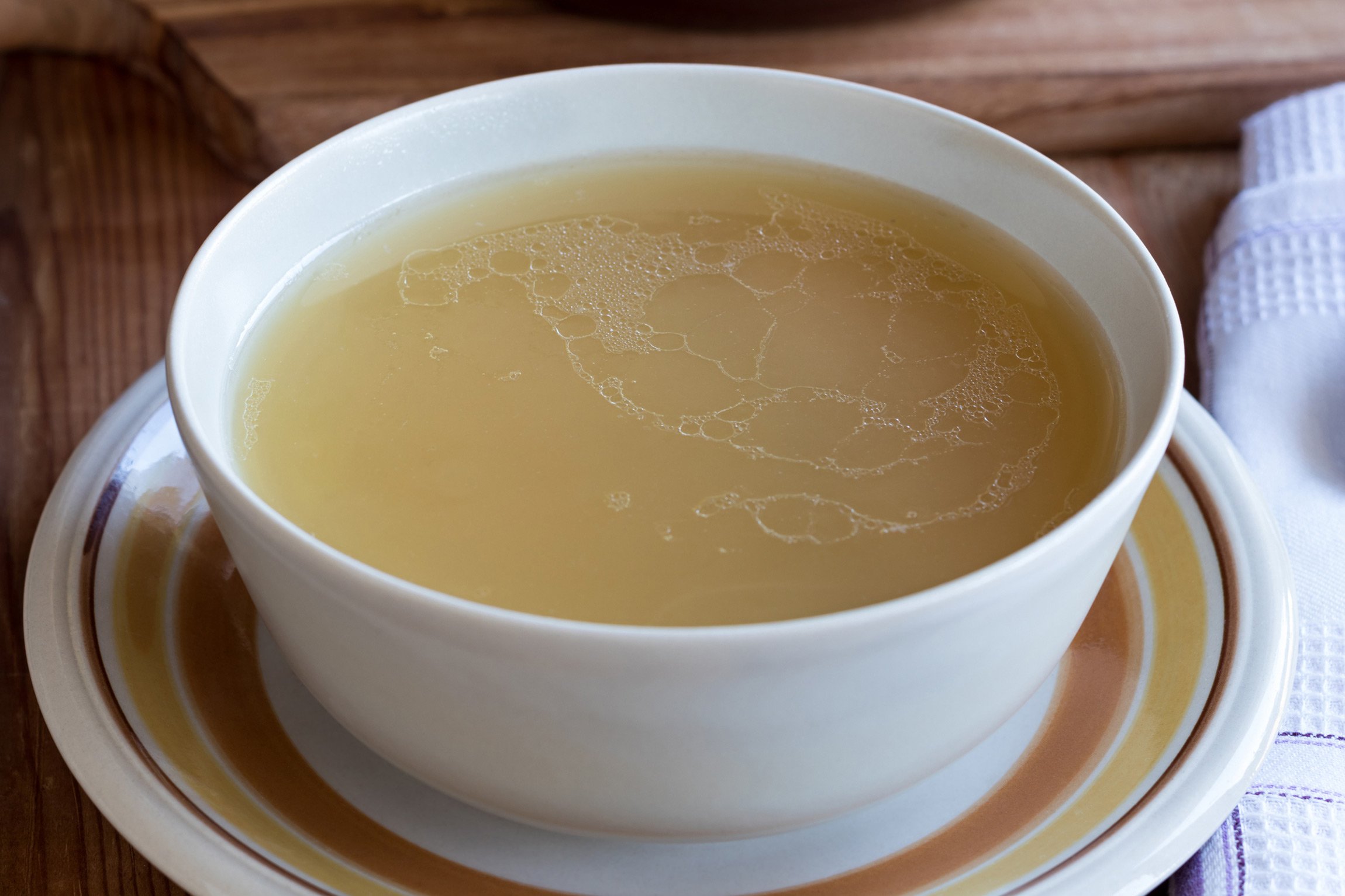
Bone broth is a broth made by boiling the roasted bones and the connective tissue of
animals for a long time.
The long cooking time — ranging from eight to over 24 hours — draws gelatin and minerals, including calcium and phosphorus, out of the bones and into the broth.
Some recipes may use apple cider vinegar or red wine, which help extract nutrients. And sometimes it will include vegetables, such as carrots, onions, and celery. Once cooked, the liquid is strained, the solid parts discarded, and the remaining broth seasoned.
There’s a growing interest in bone broth due to the long list of purported benefits. But what does the science say? Does bone broth measure up to these claims?
Claim #1: It’s a Nutritional Goldmine
Bone broth gets a lot of attention for its “unique” nutritional profile. People praise it for being a low calorie, high-protein food, and providing minerals, such as calcium, phosphorus, potassium, and magnesium.
The earliest study to mention bone broth is from 1937, which looked at the nutritional value of bone and vegetable broths. Both were common ways of nourishing infants at the time. The researchers concluded that while neither was a very good source of nutrition, the broths that provided the highest mineral content contained the most vegetables.
Far more recently, in 2017, a study in the journal Food and Nutrition Research analyzed bone broth and found that it was not an especially good source of calcium or magnesium.
While marketers tout bone broth for its mineral content, it seems the vegetables used in the cooking process — not the bones — may provide many of the helpful nutrients.
An average cup of bone broth contains zero to 19 mg of calcium and six to nine grams of protein. But when you compare it to some other sources of these nutrients, the protein content isn’t terribly impressive:
- Collard greens: 1 cup = 150 mg calcium
- Navy beans (boiled): 1 cup = 126 mg calcium
- Baked beans: 1 cup = 14 grams protein
- Unsweetened soymilk (Edensoy): 1 cup = 12 grams protein
- Peanut butter: 2 tablespoons = 7 grams protein
So yes, bone broth does provide some calcium and protein. But so do many, many other foods.
A cup of cooked kale contains ten times as much calcium as a cup of bone broth. A cup of baked beans contains nearly twice as much protein as a cup of bone broth. And most Americans may be getting too much protein (at least from animal sources), anyway.
Claim #2: It Will Strengthen Bones, Relieve Achy Joints, and Keep Skin Youthful
Collagen is the main protein in your body. It protects your organs, joints, and tendons; holds together bones and muscles, and maintains the lining of your gut. Plastic surgeons like it because it promotes skin elasticity.
Your body makes its own collagen, but as you age, you won’t make quite as much of it. So, much of the marketing says that, because bone broth contains collagen, it will help your body make more collagen.
Unfortunately, there is no evidence that eating collagen is directly helpful to your body. Many experts agree that because your body doesn’t absorb collagen in its whole form, the idea that eating collagen helps bone growth isn’t borne out in reality. Your body breaks collagen down into amino acids. So in the end, it’s just another form of protein.
You’ve probably seen collagen supplements sold for skin health. Some research suggests that collagen supplements may help to reduce visible signs of aging — like wrinkles and cellulite — but the collagen in supplements is hydrolyzed, or broken down to make it more usable for the body. The collagen in bone broth is not hydrolyzed and does not have the same effects in the body.
If you want to help your body build collagen, the best way is to eat a diet rich in leafy green vegetables because plants offer rich sources of the phytonutrients your body needs to make collagen.
These phytonutrients in plants include:
- The vitamin C found in citrus fruits, dark leafy greens, bell peppers, kiwi, berries, and broccoli. Vitamin C is a powerful antioxidant that can help protect your skin, inside and out.
- The vitamin E is present in sunflower seeds, almonds, wheat germ, spinach, and broccoli. Vitamin E works with vitamin C to promote collagen synthesis.
- The vitamin A that’s found in carrots, sweet potatoes, winter squash, dark leafy greens, cantaloupe, and apricots.
- The amino acids glycine, proline, and lysine found in dark leafy green vegetables, soy, nuts, seeds, and legumes.
- The sulfur-containing foods, such as garlic, onion, and members of the cabbage family, may also promote collagen production.
The bottom line is that many vegetables and other plant foods can be powerful allies in keeping your skin young, your bones strong, and your joints healthy.
Claim #3: It Can Cure Your Cold

At some point in your life, you probably had a bowl of chicken noodle soup while sick. It might have even helped you feel better.
Some older research studied the ability of chicken stock to ease common cold symptoms. And many people say bone broth has (or should have) a similar effect.
While there are no published studies about bone broth and illness in peer-reviewed medical journals, a few have looked at the effects of chicken soup.
A 2000 study in the journal Chest found that chicken soup could prevent white blood cells from migrating — thus preventing the worsening of upper respiratory infection symptoms.
But it also found that the vegetables in the soup — not the chicken alone — offered inhibitory effects when it came to battling infections. The researchers concluded that chicken soup likely contained multiple substances with medicinal properties.
Would vegetable soup have been just as effective? Or more effective? We don’t know. But it seems clear that the vegetables, at a minimum, played an important part.
The other chicken soup study, published in 1978, concluded that hot chicken soup was superior to cold liquids in the management of upper respiratory infections, namely in loosening nasal mucous. This sounds impressive — but then again, it’s entirely possible we could say the same thing about any hot liquid, including vegetable broth (perhaps even hot water).
Bone broth may warm your belly, but there’s no evidence that it will cure your cold. If there are immune-boosting effects, they could come from the vegetables used in its preparation.
Claim #4: It’s Good for Your Gut
Advocates claim bone broth is good for digestion and therapeutic for leaky gut syndrome — a condition in which substances can leak from your intestines into your blood.
They say the gelatin will bind water in the digestive tract, protecting the lining of your intestines. Some studies show that potential in rats, but this doesn’t mean bone broth can do the same for humans. We have very different intestinal lining than do rats. It’s possible it could help. But at this point, all we have is a theory.
What’s not a theory, because it’s been well documented, is that you can support your gut health with a variety of fiber-rich plants foods, including fermented foods, which help to maintain a healthy gut microbiome. For more ways to support digestive health with foods, see this article.
Claim #5: It Can Detoxify Your Liver

Bone broth contains the amino acid glycine. There are a few animal studies that suggest glycine supplements can benefit the liver of alcoholic rats, but none have looked at the impact of bone broth on human livers.
It’s doubtful that any single nutrient has the power to detoxify the liver by itself. The best way to protect your liver, and to protect your body from toxins, is by eating a diet that’s high in the entire array of phytonutrients found in whole plant foods.
It’s also helpful to steer clear of absorbing toxic heavy metals in the first place. And that brings us to what may be the most significant problematic fact about bone broth.
https://foodrevolution.org/blog/bone-broth-benefits/?utm_campaign=frn19-feb&utm_medium=email&utm_source=email-automated&utm_content=5033&utm_term=existing-email-list&email=shutaleva%40gmail.com&firstname=Zhanna&lastname=




Комментариев нет:
Отправить комментарий